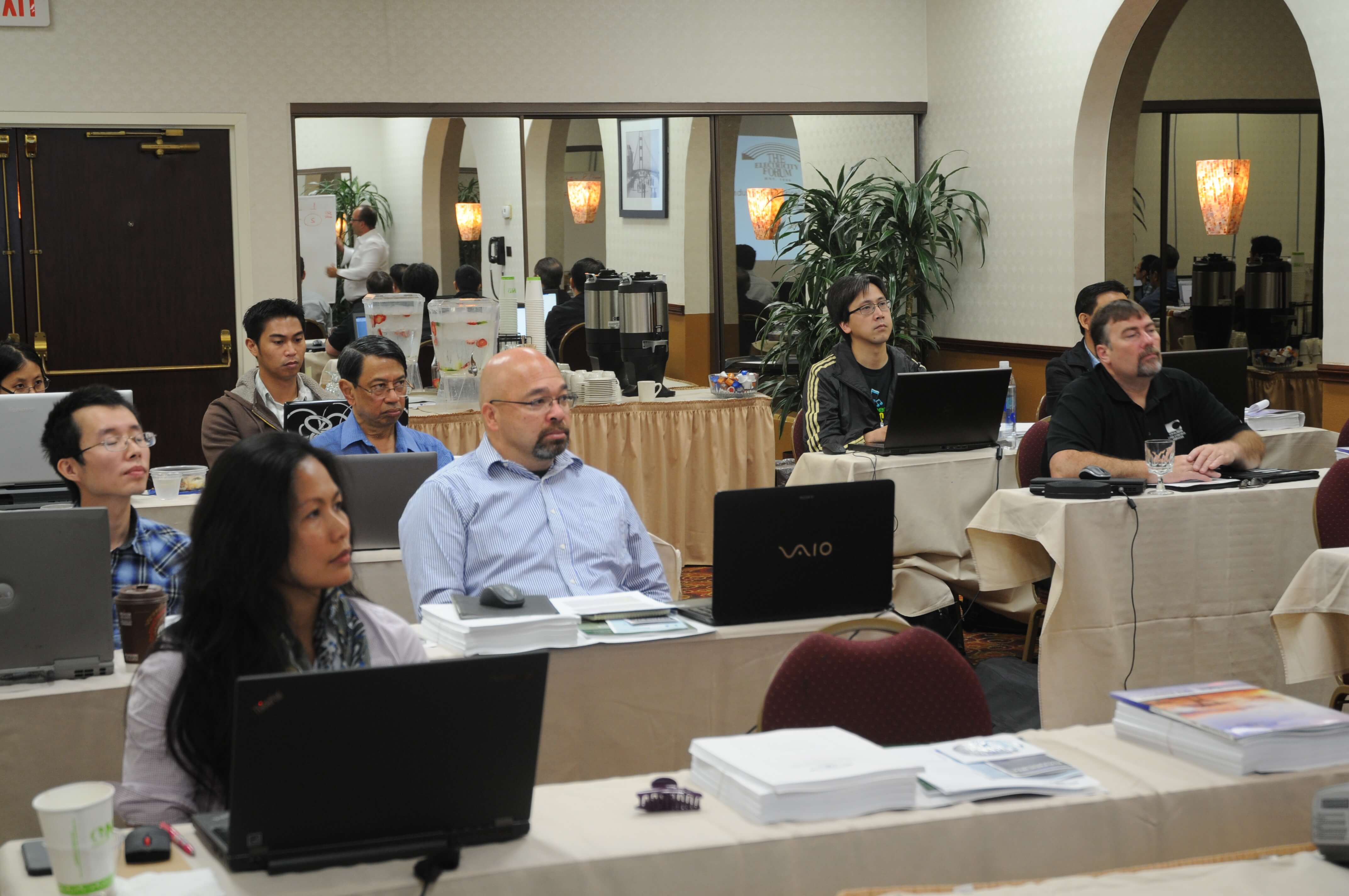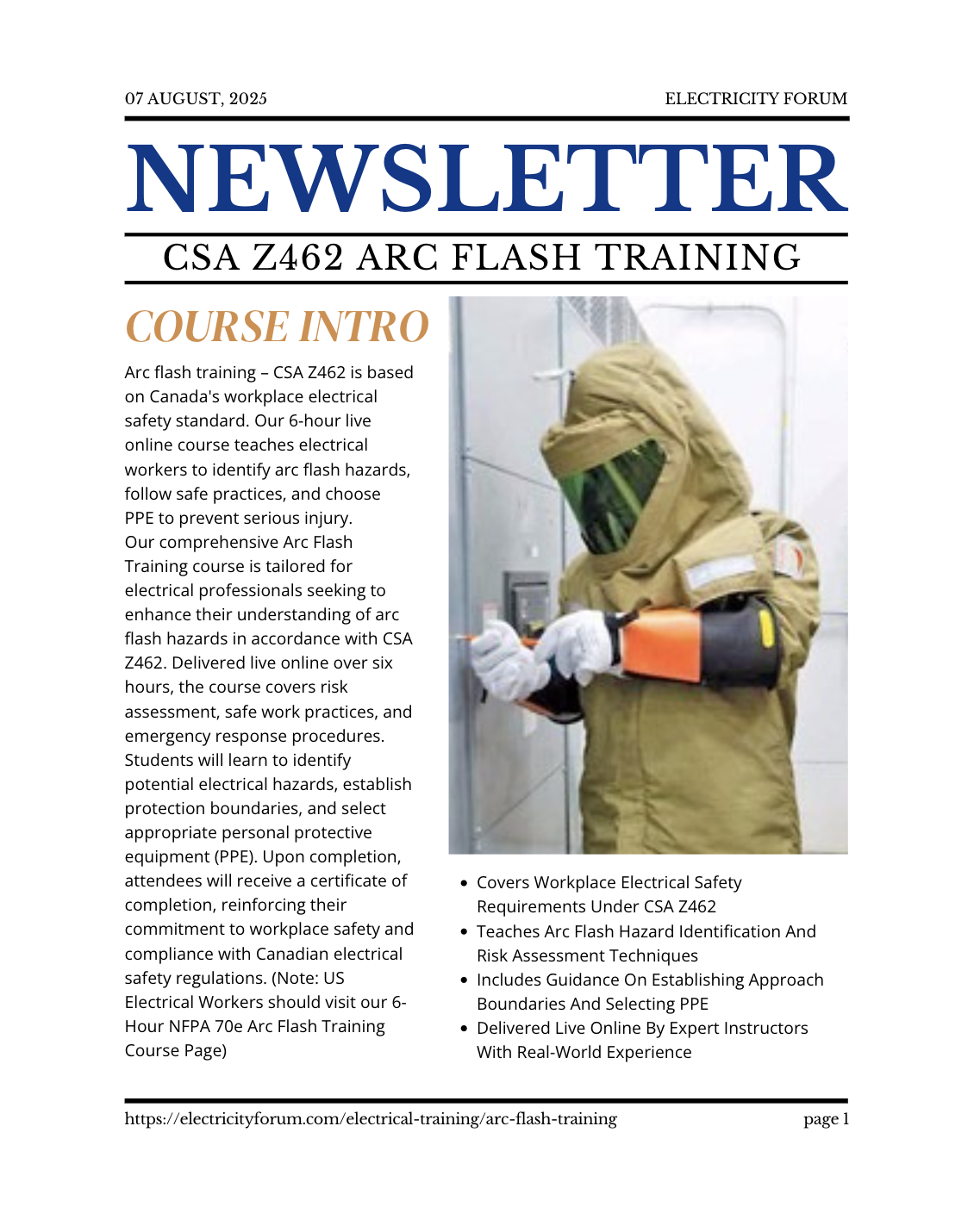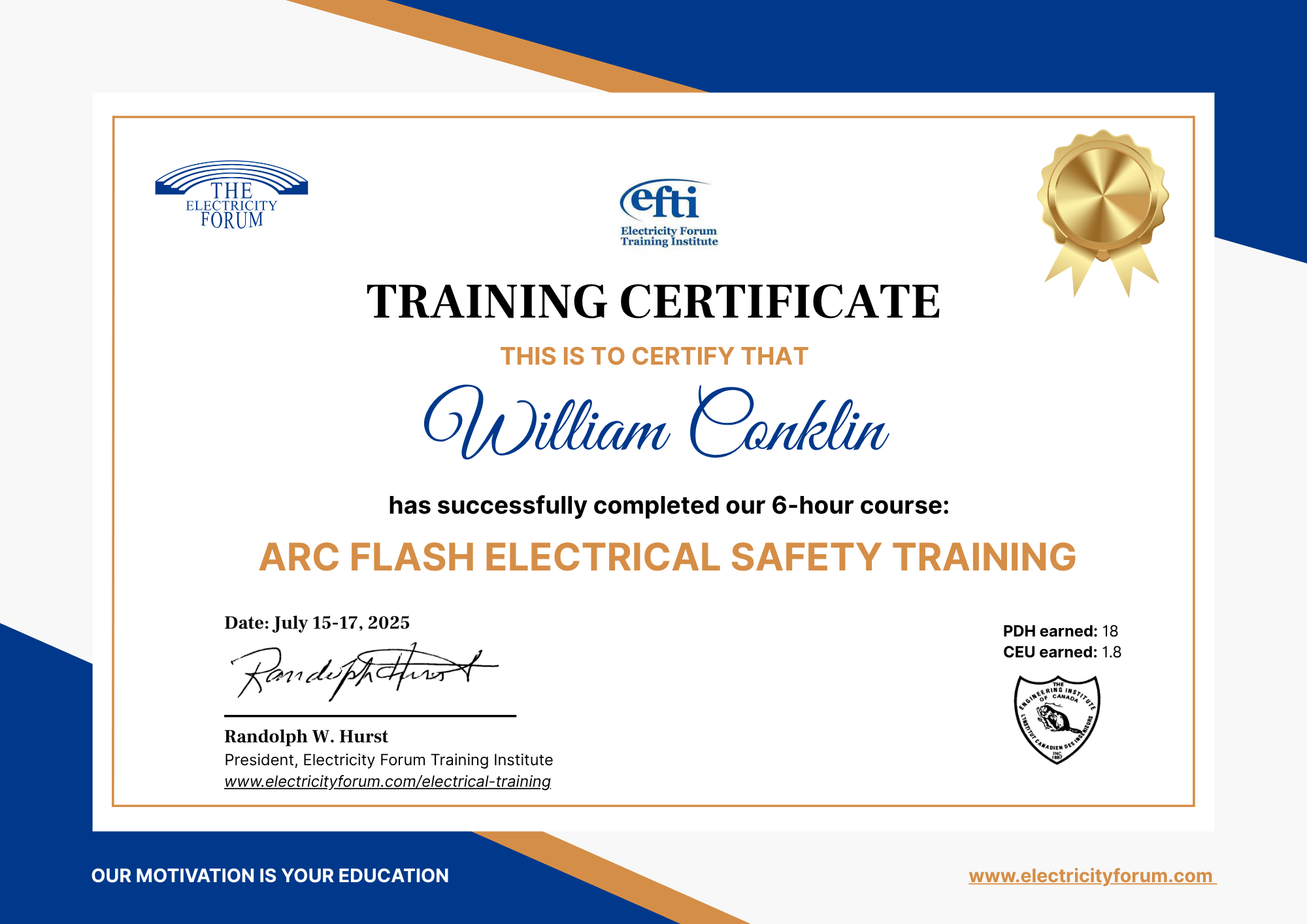DAY ONE
UNDERSTANDING ELECTRIC POWER SYSTEMS
- Time-Current Curves & Power System Studies
- Electrical Arc Characteristics
PREPARING TO WORK SAFELY
- Hazard Risk Analysis/ Task Assessment
- Assessment To Lockout Or Work Energized
- Overview Of Lockout Fundamentals
- Working Energized Defined
- Preparing A Job Briefing And Planning Checklist
- How To Plan For An Energized Electrical Work Permit
- Elements Of An Energized Electrical Work Permit
ELECTRICAL HAZARDS
- Electrical Shock
- Effects Of Current On Human Beings
- Shock Protection Boundaries
- Approach To Energized Electrical Conductors Or Circuit Parts Operating At 50 Volts Or More
- Arc Flash/ Arc Blast
- Elements And Characteristics Of An Arc Flash Event
- Arc Flash Hazard Analysis
- Arc Flash Protection Boundary For Voltages Between 50 And 600 Volts
ESTABLISHING AN ELECTRICALLY SAFE WORK CONDITION
The most effective way to prevent electrical injury is to completely remove the source of supply. This section will discuss the methods and process of achieving an electrically safe work condition. Including the following:
Working On or Near De-energized Electrical conductors or Circuit Parts That Have Lockout Devices Applied
- Principles Of Lockout Tagout Execution
- A. Employee Involvement
- B. Training
- C. Plan
- D. Control Of Energy
- E. Identification
- F. Voltage
- G. Coordination
Hazardous Electrical Energy Control Procedures
- A. Individual Qualified Employee Control Procedure
- B. Simple Lockout Tagout Procedure
- C. Complex Lockout Tagout Procedure
- D. Coordination
- E. Training And Retraining
Equipment
- A. Lock Application
- B. Lockout Tagout Device
- C. Lock Out Device
- D. Tagout Device
- E. Electrical Circuit Interlocks
- F. Control Devices
- G. Procedures
- H. Planning
DETERMINING SAFE APPROACH DISTANCE
- Determining Safe Approach Distance
- Definitions Of Boundaries And Spaces
- Limits Of Approach
- Shock Hazard Analysis
- Shock Protection Boundaries
- Limited Approach Boundary
- Restricted Approach Boundary
- Prohibited Approach Boundary
- Hazard Boundary
Shock Hazard Boundaries
- Limits Of Approach
- Preparation For Approach
- Qualified Persons, Safe Approach Distance
- Electrical Conductors Or Circuit Parts For Shock Protection
- Safe Working Distances From Energized Conductors
BASIC METHOD FOR DETERMINING ARC FLASH HAZARD ASSESSMENT
- Breakdown And Characteristics Of The 4 Hazard Risk Categories - NEW
- Selection Of Personal Protective Equipment For Various Tasks
- Hazard/ Risk Category Classification
- Protective Clothing And Personal Protective Equipment (PPE)
- Protective Clothing Characteristics
- Factors In the Selection Of Protective Clothing And Equipment
- Two Category, Flame Resistant (HRC/ Hazard Risk Category) Clothing System - NEW
- Layering Protective Clothing And Total System Arc Rating
- Arc Rating, Arc Thermal Performance Value (ATPV) And Break-Open Threshold Energy (EBT)
- Brief Overview Of Applicable ASTM Standards For Protective Clothing And PPE
Safety-related Electrical Maintenance
- Introduction
- Frequency Of Maintenance Tests
- Maintaining Electrical Drawings
- Maintenance Standards
Electrical Hazard Labels, Arc Flash and Shock Labelling
- General
- Canadian Electrical Code Rule 2-306 Shock And Arc Flash Warning Label
- Arc Flash Label Example
- Detailed Arc Flash Hazard Analysis Label - NEW
NEW ANNEX: Prevention of Shock Injuries from Electrostatic Discharges
Prevention of Shock Injuries from Electrostatic Discharges describes workplace scenarios, such as high-speed network operations, in which the potential for shock injury from electrostatic discharge exists. This Annex identifies methods to prevent, control, and protect personnel from injury.
NEW: DC Safety-related Work Practices
The 3rd edition of Z462 provides considerably more information on safety-related practices for work on and around DC systems. A new Shock Protection Boundary Table for DC systems and an arc flash energy calculation method for DC systems have been added. Extensive revisions have been made to deal with safety-related practices for batteries, battery rooms and battery enclosures. Both high value for anyone working on or around DC equipment. This new additional information is essential for working on DC systems.
ARC FLASH SOLUTIONS
- Arc Flash Study Analysis And Implementation
- Power System Upgrades
- Arc Resistant Switchgear
- Circuit Breaker Retrofitting
- Remote Breaker Racking
- Regular Maintenance And Testing
- Arc-Rated Power Switchgear
- Light Sensing Trip Breakers
- GE Arc Vault Protection System
CSA Z462 PPE CLOTHING REQUIREMENTS, Arc Rated CLOTHING TESTING STANDARDS, HOW TO ESTABLISH A PPE PROGRAM IN YOUR COMPANY
- The Evolution Of Arc-Resistant (AR Or HRC) Fabrics
- Changes In Clothing Requirements In Electrical Work - New
- The Various Types Of HRC Fabrics That Are Available In The Marketplace
- HRC Fabrics And The Effects Of Undergarments
- Review The Technology And Effectiveness Of Inherently Flame-Resistant Fibres Vs Chemically Treated Fabrics
- Developing A PPE Program In Your Company
- Assessing The Correct Arc Flash Hazard And Choosing The Right Level Of Protective Clothing
- Company Training And Worker Compliance
- Documentation QUIZ
- A Quiz To Ensure Student Understanding Of The Day's Information
DAY TWO
Recognizing Electrical Safety Hazards - Where Do They Exist?
A detailed review of critical electrical safety hazards created by energized electrical equipment:
- Insulation
- Power Cables
- Power Transformers
- Instrument Transformers
- Dealing With Fault Currents
- Disconnect Switches
- Switchgear
- Circuit Breakers
- Fuses
- Electrical Relays
- Motor Starters
- AC/DC Motors
- Capacitors
- Emergency UPS Systems
Resolving Electrical Safety Hazards
Objective: Determine the controls used to protect workers from all energy sources created in the workplace. Benefits of a safe workplace include fewer injuries, lower worker compensation costs, reduced service interruptions, greater protection of capital investment, and increased uptime. This section will provide you with a detailed blueprint that maximizes electrical safety and all the benefits it generates.
- Hierarchy Of Controls
- Management Control
- Legislation
- Electrical Code
- Purchasing Controls
- Engineering Controls
- Training
- Safety Documentation
- Rules
- Safe Work Practices
- Safe Work Procedures
- Codes Of Practice
- Operating Procedures
- Permits & Clearances
- Switching Procedures
- Physical Equipment
- Personal Protective Equipment
- Safety Equipment
- Signs And Barriers
- Equipment Protection
- Interlock
- Grounding
- Field Control
- Inspections
- Job Planning
- Pre-Job Meeting
- Hazard Identification
- Hazard Reporting
- Work Methods
- Limits Of Approach
- Switching Practices
GENERAL ELECTRICAL SAFETY REQUIREMENTS
- Review Of Standards And OH&S Regulations
- HV Electrical Qualifications
- Poles And Structures
- Obstructions On Poles
- Properly Informing Electrical Workers
- Working In Service Rooms
- Space Around Equipment
- Working With HV Test Equipment
- Insulated Aerial Devices
SWITCHING
This section of the course will instruct on how to: interpret and use a single-line diagram to write a switching sequence to safely isolate an electrical device for work; validate existing operating orders and switching procedures; and develop and maintain mandated documentation for all electrical equipment isolation and maintenance work.
- Single Line Diagrams
- Using Prints
- Electrical System Drawings
- Safety Documentation
- Isolation
- Lockout/Isolation
- Switching Workshop
WORKING ON HIGH VOLTAGE ELECTRICAL EQUIPMENT
- Isolation And Lockout
- Warning Signs
WORKING ON DE-ENERGIZED HIGH VOLTAGE POWER SYSTEMS
- Isolation And Lockout
- Person In Charge
- Switching Sequences
- Isolating Devices
- Grounding And Blocking
- Working With Multiple Authorities
WORKING CLOSE TO ENERGIZED HIGH VOLTAGE EQUIPMENT AND CONDUCTORS
- Minimum Clearances
- General Limits Of Approach
- Assurance In Writing
- Assurance Not Practicable
- When Is A Worker Specially Trained And Qualified
- Adjusted Limits Of Approach
- Emergency Work Procedures
- Authorization By Owner To Perform Work
COURSE SCHEDULE:
Both days:
Start: 10 a.m. Eastern Time
Finish: 4:30 p.m. Eastern Time

















